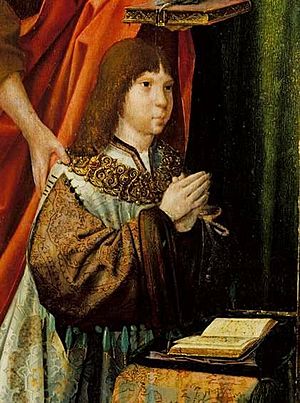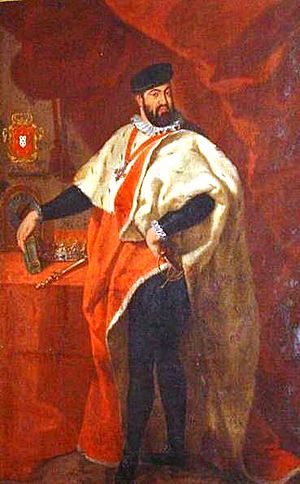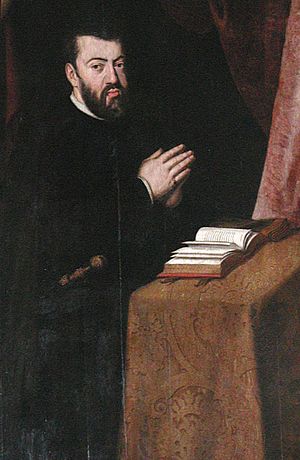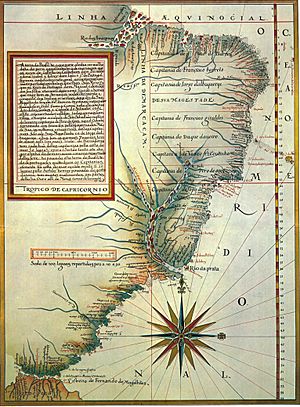John III of Portugal facts for kids
Quick facts for kids John III |
|
|---|---|
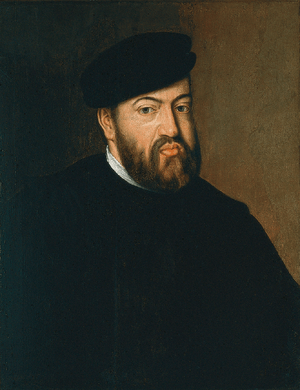
Portrait of John attributed to Cristóvão Lopes, copy of a 1552 original by Anthonis Mor
|
|
| King of Portugal | |
| Reign | 13 December 1521 – 11 June 1557 |
| Acclamation | 19 December 1521 |
| Predecessor | Manuel I |
| Successor | Sebastian |
| Born | 7 June 1502 Alcáçova Palace, Lisbon |
| Died | 11 June 1557 (aged 55) Ribeira Palace, Lisbon |
| Burial | Jerónimos Monastery |
| Spouse | |
| Issue among others... |
Afonso, Hereditary Prince of Portugal Maria Manuela, Princess of Asturias Manuel, Hereditary Prince of Portugal Philip, Hereditary Prince of Portugal João Manuel, Prince of Portugal |
| House | Aviz |
| Father | Manuel I of Portugal |
| Mother | Maria of Aragon |
| Religion | Roman Catholicism |
| Signature | |
John III (Portuguese: João III Portuguese pronunciation: [ʒuˈɐ̃w̃]; born June 7, 1502 – died June 11, 1557) was the King of Portugal and the Algarves. He ruled from 1521 until his death in 1557. People called him The Pious (Portuguese: o Piedoso) because he was very religious.
John III was the son of King Manuel I and Maria of Aragon. He became king in 1521 when he was 19 years old.
During his time as king, Portugal's lands grew bigger in Asia and the Americas. This happened through the Portuguese colonization of Brazil. John III made sure Portugal kept its control over the spice trade from places like the Maluku Islands. By the time he died, the Portuguese empire was huge and spread across almost 4 million square kilometers around the world.
Under his rule, the Portuguese were the first Europeans to meet people from Japan. He also decided to focus more on trade with India and Brazil, rather than keeping all the lands in North Africa. In Europe, he made friends with countries in the Baltic region and the Rhineland to help Portuguese trade.
Contents
Early Life of King John III
John was born in Lisbon on June 7, 1502. He was the oldest son of King Manuel I and his second wife, Maria of Aragon. When he was born, a special play was performed to celebrate.
He became the official heir to the throne in 1503. John had excellent teachers who taught him about many subjects, including stars and law.
One of his biographers said that John was good at solving problems. He learned a lot from actually doing things, which helped him throughout his reign. In 1514, he got his own household. A few years later, he started helping his father with royal duties.
When John was 16, he was supposed to marry his cousin, Eleanor of Austria. But instead, Eleanor married his widowed father, King Manuel. This upset John very much. Some historians believe this made him become very religious, which is why he was called the Pious.
Starting His Reign as King
On December 19, 1521, John was crowned king in Lisbon. He ruled for 36 years. This time was busy with many decisions about Portugal and its lands overseas. He also dealt with other big European countries.
John III continued the way his father ruled, where the king had most of the power. He only called the Portuguese parliament (called the Portuguese Cortes) three times during his reign. In the early years, he also worked to improve how the government and justice system worked.
John's sister, Isabella of Portugal, married Charles V, who was the Holy Roman Emperor and King of Spain. This helped Portugal become stronger friends with Spain and the Holy Roman Empire. To make his ties with Austria even stronger, John married his cousin, Catherine of Austria. She was Charles V's younger sister.
John III and Catherine had nine children, but sadly, most of them died young. By the time John died, only his grandson, Sebastian, was alive to become the next king.
King John III's Policies
The huge Portuguese Empire was hard and expensive to manage. Portugal also had many debts. The Portuguese lands in India and the Far East became difficult to control because of poor leadership. John III tried to fix this by appointing new governors, but it was still a challenge. This led to a slow decline in Portugal's control over the spice trade. To help with military needs, John III announced in 1549 that every man between 20 and 65 years old could be called for military service.
Portugal's empire faced threats from the Ottoman Empire in the Indian Ocean and North Africa. This meant Portugal had to spend more money on defense. In the Atlantic, French ships often attacked Portuguese vessels. French settlers also started a colony in Brazil, making alliances with local people against the Portuguese. The French were eventually forced out, but not until 1565.
In the early years of John III's rule, Portuguese explorers continued their journeys. They reached China and Japan. However, the powerful Ottoman Empire under Suleiman the Magnificent caused problems, especially in India. Defending these interests was very expensive. To save money, John III gave up some Portuguese strongholds in North Africa, like Safim and Azamor.
John III achieved an important win by securing control of the Maluku Islands, also known as the "Spice Islands." Spain had also claimed these islands. After nearly ten years of small fights, John III signed the Treaty of Zaragoza with Emperor Charles V in 1529. This treaty set the boundaries for Spanish and Portuguese influence in Asia.
International Relationships
John III's reign was known for its active diplomacy. He made alliances with Spain through many royal marriages. This helped keep peace in the Iberian Peninsula for years. He married Catherine of Austria, and his sister Isabella of Portugal married Charles V. His daughter Maria Manuela married Philip II of Spain. However, these marriages between closely related royal families might have contributed to the poor health of John's children and future King Sebastian of Portugal.
John III stayed neutral during the war between France and Spain. But he was firm in fighting off attacks from French privateers (pirates).
He also made relations stronger with the Papal States (the lands ruled by the Pope). He brought the Inquisition to Portugal and made sure the Portuguese church followed the Counter-Reformation. This good relationship with the Catholic Church allowed John to appoint people he trusted to important religious jobs. For example, his brothers Henry and Afonso became Cardinals.
Trade grew stronger with England, the Baltic countries, and Flanders during John III's rule. On the other side of the world, Portugal was the first European country to reach Japan. In China, the city of Macau was given to the Portuguese. Soon, Portugal controlled major trade routes in that area. In South Asia, the Portuguese continued to fight against their Muslim rivals and local Indian leaders.
Culture and Learning
John III was a big supporter of the humanist movement. This was a time when people focused on human values and achievements. He actively supported famous writers like Gil Vicente and Luís de Camões. He also helped scientists like the mathematician Pedro Nunes and the doctor Garcia de Orta.
The king gave many scholarships for students to study at universities in other countries, especially in Paris. He also moved the Portuguese university from Lisbon to Coimbra in 1537.
In 1542, John III created a College of Arts in Coimbra. He brought many important teachers from Portugal and Europe to teach there. The king gave the university excellent resources.
Another important part of John III's rule was his support for missionaries. These were people who traveled to spread Christianity in the New World, Asia, and Africa. In 1540, John III asked Pope Paul III for missionaries for the Portuguese lands in India. He appointed Francis Xavier to lead this effort. The Jesuits, a new religious group, were very important in helping the Portuguese interact with native peoples.
The Inquisition in Portugal
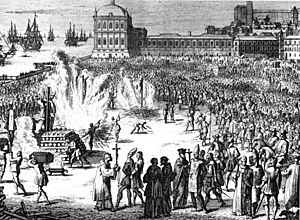
The Inquisition was brought to Portugal in 1536. Like in Spain, the king had control over the Inquisition.
The Grand Inquisitor was chosen by the Pope after the king nominated someone. This person always came from the royal family. The Grand Inquisitor would then choose other inquisitors. In Portugal, the first Grand Inquisitor was Cardinal Henry, who was the king's brother and later became king himself.
There were Inquisition courts in Lisbon, Coimbra, Évora, and from 1560 onwards, in Goa (India). The Goa Inquisition significantly changed the population of Goa. Goa became a very important trading center.
The Portuguese developed Goa by building modern buildings, strong roads, and bridges that are still used today.
The Inquisition did many things, like censoring books and punishing people for divination (predicting the future), witchcraft, and bigamy (being married to more than one person).
Even though it was first created to punish religious differences, the Inquisition became very powerful. It influenced almost every part of Portuguese society, including politics, culture, and social customs.
Managing the Empire

Portugal's Relations with Africa
During John III's time, trade between the Portuguese and Africans was very active. They traded at places called feitorias (trading posts) like Arguim, Mina, and Mombasa. Under John III, several groups of explorers, traders, and missionaries traveled from the African coast into the continent. The goal was to expand the king's dominion, create peaceful relationships, and teach Christianity to the local people. However, trade in slaves often made relations with local rulers difficult.
John III decided not to give up all the Portuguese strongholds in North Africa. He chose which ones to keep based on their economic or military importance. He left Safim and Azamor in 1541, and then Arzila and Alcácer Ceguer in 1549. But he strengthened the fortresses of Ceuta, Tangiers, and Mazagan to handle new military weapons like heavy cannons.
John III even had a black African man named João de Sá Panasco as his court jester. This man later joined the respected Order of Saint James because of his service in a battle.
Portugal's Relations with Asia
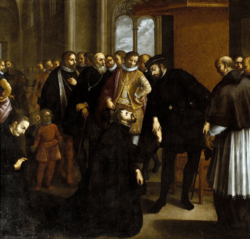
Before John III became king, the Portuguese had already reached places like Siam (1511), the Maluku Islands (1512), and the coast of China (1513). During John's rule, the Portuguese reached Japan. By the end of his reign, China offered Macau to Portugal.
From India, John III imported many different spices, herbs, and fabrics. From Malacca, he got exotic woods and more spices. From China, he imported silk and musk. In return, Portugal sent things like pearls, horses, and salt.
It was very hard for John III to keep Portuguese control in India because it was so far away and Muslim groups often attacked Portuguese ships. A viceroy (a powerful governor) was appointed, but it wasn't enough. The Portuguese first set up trading posts to control trade.
Because many Indian kingdoms and sultans fought against the Portuguese, Portugal had to take military control of some key cities. Goa became the main center of the Portuguese Empire in the East in 1512. Goa became a place where European culture and religion were introduced to India. Churches, schools, and hospitals were built there. Goa remained a Portuguese territory until India took it back in 1961.
The Portuguese arrived in Japan in 1543. Some say the writer Fernão Mendes Pinto was the first Portuguese person to arrive, while others say it was navigators like António Peixoto.
Portuguese traders started doing business with Japan around 1550 and set up a base in Nagasaki. By then, Portugal had a monopoly on trade with Japan. Because the Portuguese were also in Macau, trade between China and Japan improved under John III's rule.
After Ferdinand Magellan's voyage, Spain claimed the newly discovered Maluku Islands. In 1524, experts met to solve this disagreement. The Portuguese team sent by John III included famous mapmakers and navigators. The dispute was settled in 1529 by the Treaty of Zaragoza. Portugal paid Spain 350,000 gold coins to secure their presence in the islands.
In 1553, Leonel de Sousa got permission for the Portuguese to settle in Canton and Macau. Macau was later given to John III as a reward for Portugal's help against pirates between 1557 and 1564. Malacca, which controlled an important strait, was vital for Portuguese interests in the Far East. After an earlier attempt failed, Malacca was finally captured by Afonso de Albuquerque, the Portuguese viceroy of India, in 1511.
To follow its trade routes to the Far East, Portugal relied on the seasonal monsoon winds in the Indian Ocean. This meant Portugal needed permanent bases in India to wait for the winds to change. Besides Goa, they also took control of parts of Ceylon (now Sri Lanka).
Portuguese America: Brazil
During King John III's reign, the Portuguese Empire established itself in South America. They created twelve Captaincy Colonies of Brazil starting in 1534. Each colony had its own leader. In 1549, John III created the Governorate General of Brazil, and the colonies then reported to this main government. The first Governor-General, Tomé de Sousa, founded the city of Salvador, Bahia in 1549. Because of his role in colonizing South America, John III is sometimes called "The Colonizer" (Portuguese: "o Colonizador").
After Brazil was discovered in 1500, the Portuguese first imported brazilwood, local slaves, and exotic birds. Brazilwood was valuable in Europe for making red dye. During John III's rule, Portuguese explorers looked for more brazilwood. They also started growing sugarcane, which grew well in Brazil's climate, especially around Recife and Bahía.
In the last years of John's reign, Portugal's colony of Brazil began to grow quickly as a sugar producer. This helped make up for the money Portugal was losing from Asia. This growth continued under his grandson, Sebastian. Since Brazil didn't have a large native population that was used to hard farm work, the Portuguese colonists started bringing in African slaves. The first slaves arrived in Brazil in 1539. Most of them worked in the sugarcane fields or as house servants.
Death and His Family
From 1539, the heir to the throne was João Manuel, Prince of Portugal. He married Joanna of Austria, Princess of Portugal, who was the daughter of Charles V. Prince John Manuel was the only son of John III to live past childhood, but he was sick and died young from a disease. He died just 18 days before his wife gave birth to Prince Sebastian on January 20, 1554.
When John III died of a stroke in 1557, his only heir was his three-year-old grandson, Sebastian.
John III's body is buried in the Monastery of Jerónimos in Lisbon.
| Name | Birth | Death | Notes |
|---|---|---|---|
| Children with Catherine of Austria (married February 10, 1525) | |||
| Prince Afonso | February 24, 1526 | April 12, 1526 | Prince of Portugal (1526). |
| Princess Maria Manuela | October 15, 1527 | August 12, 1545 | Princess of Portugal (1527–1531). She became Princess of Asturias by marrying King Philip II of Spain. She died a few days after giving birth to her son, Prince Carlos. |
| Infanta Isabel | April 28, 1529 | April 28, 1529 | |
| Infanta Beatriz (Beatrice) | February 15, 1530 | February 15, 1530 | |
| Prince Manuel | November 1, 1531 | April 14, 1537 | Prince of Portugal (1531–1537). He was declared the heir in 1535. |
| Prince Filipe (Philip) | March 25, 1533 | April 29, 1539 | Prince of Portugal (1537–1539). He was declared the heir in 1537. |
| Infante Dinis (Denis) | April 6, 1535 | January 1, 1537 | |
| Prince João Manuel | June 3, 1537 | January 2, 1554 | Prince of Portugal (1537–1554). He was declared the heir in 1539. He married Joan of Spain. Their son became King Sebastian I. |
| Infante António (Anthony) | March 9, 1539 | January 20, 1540 | |
| Natural son | |||
| Duarte, Archbishop of Braga | 1529 | November 11, 1543 | |
How John III Was Called
Like the kings before him, John III used the title "El-rei" (the king) followed by "Dom" (short for D.). This was a special way to show respect for an important Christian nobleman.
His official title was the same as his father Manuel I's: "Dom João, by the grace of God, King of Portugal, of the Algarves, of either side of the sea in Africa, Lord of Guinea, & of the Conquest, Navigation, & Commerce of Ethiopia, Arabia, Persia, & India". This title stayed the same until the 19th century when Brazil became a Vice-Kingdom.
See also
 In Spanish: Juan III de Portugal para niños
In Spanish: Juan III de Portugal para niños
- Descendants of Manuel I of Portugal


